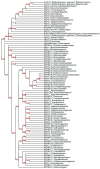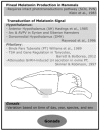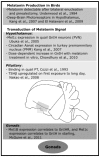Seasonal Reproduction in Vertebrates: Melatonin Synthesis, Binding, and Functionality Using Tinbergen's Four Questions
- PMID: 29534047
- PMCID: PMC6017951
- DOI: 10.3390/molecules23030652
Seasonal Reproduction in Vertebrates: Melatonin Synthesis, Binding, and Functionality Using Tinbergen's Four Questions
Abstract
One of the many functions of melatonin in vertebrates is seasonal reproductive timing. Longer nights in winter correspond to an extended duration of melatonin secretion. The purpose of this review is to discuss melatonin synthesis, receptor subtypes, and function in the context of seasonality across vertebrates. We conclude with Tinbergen's Four Questions to create a comparative framework for future melatonin research in the context of seasonal reproduction.
Keywords: melatonin; seasonal reproduction; vertebrates.
Conflict of interest statement
The Authors declare that there is no conflict of interest.
Figures






Similar articles
-
An integrative overview of the role of gonadotropin-inhibitory hormone in behavior: applying Tinbergen's four questions.Gen Comp Endocrinol. 2014 Jul 1;203:95-105. doi: 10.1016/j.ygcen.2014.03.028. Epub 2014 Apr 3. Gen Comp Endocrinol. 2014. PMID: 24704003 Review.
-
Research progress on the role of melatonin and its receptors in animal reproduction: A comprehensive review.Reprod Domest Anim. 2018 Aug;53(4):831-849. doi: 10.1111/rda.13188. Epub 2018 Apr 16. Reprod Domest Anim. 2018. PMID: 29663591 Review.
-
Melatonin distribution reveals clues to its biological significance in basal metazoans.PLoS One. 2012;7(12):e52266. doi: 10.1371/journal.pone.0052266. Epub 2012 Dec 26. PLoS One. 2012. PMID: 23300630 Free PMC article.
-
Melatonin and Female Reproduction: An Expanding Universe.Front Endocrinol (Lausanne). 2020 Mar 6;11:85. doi: 10.3389/fendo.2020.00085. eCollection 2020. Front Endocrinol (Lausanne). 2020. PMID: 32210911 Free PMC article. Review.
-
Melatonin: an internal signal for daily and seasonal timing.Indian J Exp Biol. 2014 May;52(5):425-37. Indian J Exp Biol. 2014. PMID: 24851405 Review.
Cited by
-
The Role of Melatonin to Ameliorate Oxidative Stress in Sperm Cells.Int J Mol Sci. 2023 Oct 11;24(20):15056. doi: 10.3390/ijms242015056. Int J Mol Sci. 2023. PMID: 37894737 Free PMC article. Review.
-
Testicular Melatonin and Its Pathway in Roe Deer Bucks (Capreolus capreolus) during Pre- and Post-Rut Periods: Correlation with Testicular Involution.Animals (Basel). 2021 Jun 23;11(7):1874. doi: 10.3390/ani11071874. Animals (Basel). 2021. PMID: 34201764 Free PMC article.
-
Mediterranean Pine Vole, Microtus duodecimcostatus: A Paradigm of an Opportunistic Breeder.Animals (Basel). 2021 Jun 1;11(6):1639. doi: 10.3390/ani11061639. Animals (Basel). 2021. PMID: 34205873 Free PMC article.
-
Melatonin Alleviates Hypoxia-Induced Apoptosis of Granulosa Cells by Reducing ROS and Activating MTNR1B-PKA-Caspase8/9 Pathway.Antioxidants (Basel). 2021 Jan 28;10(2):184. doi: 10.3390/antiox10020184. Antioxidants (Basel). 2021. PMID: 33525391 Free PMC article.
-
Fluctuations in Seminal Quality throughout the Year: How do Temperature, Humidity and Atmospheric Pressure Impact on Human Sperm Quality?J Hum Reprod Sci. 2023 Jul-Sep;16(3):185-194. doi: 10.4103/jhrs.jhrs_101_23. Epub 2023 Sep 29. J Hum Reprod Sci. 2023. PMID: 38045501 Free PMC article.
References
-
- Tan D.-X., Manchester L.C., Liu X., Rosales-Corral S.A., Acuna-Castroviejo D., Reiter R.J. Mitochondria and chloroplasts as the original sites of melatonin synthesis: A hypothesis related to melatonin’s primary function and evolution in eukaryotes. J. Pineal Res. 2013;54:127–138. doi: 10.1111/jpi.12026. - DOI - PubMed
Publication types
MeSH terms
Substances
LinkOut - more resources
Full Text Sources
Other Literature Sources

